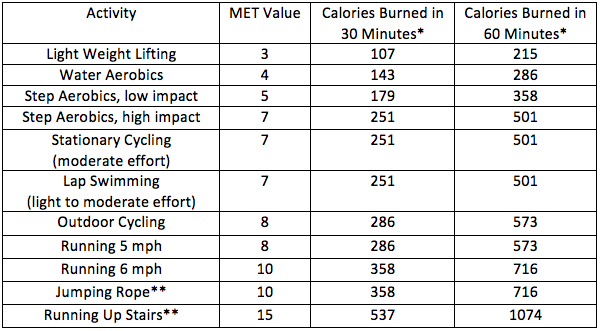Here is an article from The Salt Lake City Daily Herald. I am including it as it does show the way that METs which are a calculation of workout based on oxygen consumption.
Disheartened by a failed marriage and years of gain, Ellen Bowden decided to turn to a personal trainer to help reshape her body and lifestyle.
Since January, the 47-year-old Salt Lake City court mediator has lost 11 percent body fat, shed about 25 pounds, improved her diet, quit smoking and toned up under the guidance of Michael Streeter at the 24 Hour Fitness center in Sugar House.
Streeter designed an exercise program for Bowden using the Karvonen formula, which calculates a person’s target heart rate by a person’s age and pulse. Three or four days a week, Bowden hits her rate of 144 on the elliptical machine.
According to new research on women and fitness, she also should be able to reach about 8.5 METs — but that means little to her.
What are METs?
MET stands for metabolic equivalents. It is displayed on most elliptical trainers, treadmills, and other cardiovascular exercise machines, and is a measure of a capacity for exercise based on the level of oxygen a person is consuming. A Chicago study published in The New England Journal of Medicine earlier this month — which provides the first fitness guidelines based on research on women — used METS as its measure.
A Chicago study published in The New England Journal of Medicine earlier this month — which provides the first fitness guidelines based on research on women — used METS as its measure.

Cardiologist Martha Gulati and a team of researchers at Chicago’s Rush University Medical Center studied nearly 6,000 women during 10 years beginning in 1992 to gather their data. Gulati said cardiologists have used MET levels as part of cardiac treadmill tests for years, and she believes METs will become mainstream.
“I don’t think it’s at all complicated,” she said. “A lot of people work out on the treadmill, and most of the cardio machines have on (them) how many METs you are going. It’s a question of understanding what that means.”
Moderate walking burns 3 to 6 METs per minute. According to Gulati’s research, a fit 40-year-old woman should be able to reach 9.5 METs while exercising, while an 80-year-old woman should be able to hit 5.
Experts Like Using METs to Rate Fitness
Frank Yanowitz, medical director of The Fitness Institute at LDS Hospital, said METs can help people understand how fit — or unfit — they are.
“Where METs are a little more useful is in the testing environment, when we’re trying to assess one’s fitness level on a treadmill,” he said. “If we can define a low-fit subgroup of people, that information is useful in motivating a person to start an exercise program, and it shows that they may be more prone to diseases.”
Bowden and Streeter are skeptical.
“When I first came in, if Michael had sat here and calculated my target MET level, I would have been completely overwhelmed,” Bowden said. “It would have been very discouraging.”
Streeter adds: “I’ve been doing this for four years, and I didn’t even know what a MET was. I don’t want to invest the time in learning about it because I know what works.”
Ashley Jensen, an aerobics instructor and personal trainer at 24 Hour Fitness, agrees the MET standard is hard to convey to clients. They more easily understand heart rates and calories burned.
“If you’re talking about women, we are moms, we work and we are so busy we don’t have time for a confusing chart,” Jensen said.
Melissa Walred, manager of Ladies Workout Express in Sandy, pushes her clients to work out for at least 30 minutes at the highest exertion level they can handle.
“People like stuff simple,” she said. “We have a lot of clients with diabetes and high blood pressure, and they’re not interested in something so complicated.”
But Mike Young, the personal training director at XCel Spa and Fitness in Holladay, finds the MET system useful.
“For clients who want a high intensity workout, I will tell them they want to reach 10 to 12 METs,” he said. “It’s not that hard if you understand it, but most members and even a lot of trainers may not know about it.”
METs can be Very Visual
Working out on an elliptical trainer, Marci King could see that she was hitting 14.6 METs, well above her target fitness rate. The active 31-year-old was the rare exception, however, in understanding METs, which she learned about at the University of Utah while studying exercise and sports science.
“Sometimes it’s easier to gauge how hard you are working by looking at MET than heart rate,” she said. “And I think it’s good for interval training.”
Across the gym walking briskly on a treadmill, Stephanie Christian, 27, said she never looks at her MET level.
“I think most people look at minutes or calories burned,” she said. “I knew MET had something to do with oxygen, but I wasn’t sure what it meant.”
Carey Hamilton is a reporter for the Salt Lake Tribune. This story first appeared in the Tribune on Aug. 23, 2005.
The post The Value of METs in Weight Loss Workouts appeared first on Fitness Tips for Life.
http://ift.tt/1NFZdwP
No comments:
Post a Comment